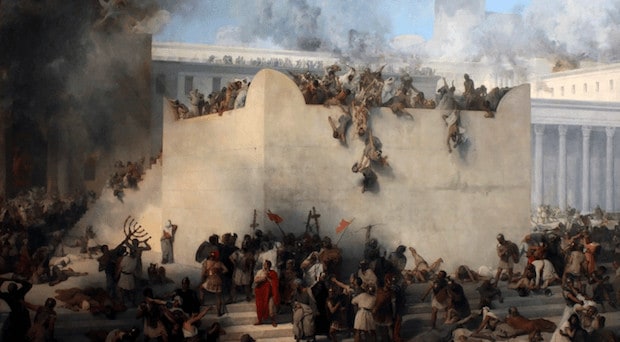Is the book of Revelation a linear chronology of distant future events? Or does the book describe the Roman persecution of Christians and Rome’s destruction of the temple—events that occurred in John’s lifetime? The first view opts for a mid-AD 90s authorship (long after the temple was destroyed), the second supports a pre-AD 70s authorship (when the temple was still standing). Each of these readings is complicated by Revelation 11:1–2:
Then I was given a measuring rod like a staff, and I was told, “Rise and measure the temple of God and the altar and those who worship there, but do not measure the court outside the temple; leave that out, for it is given over to the nations, and they will trample the holy city for forty-two months.”
Taken literally, these verses indicate the Jerusalem temple still stands—apparent proof that Revelation was written before ad 70. If so, the idea that John is describing the Roman persecution and invasion—empowered by Satan and his hatred for the Church—must be valid. However, while the defense of this view takes this passage literally, most people who prefer to see Revelation written before ad 70 read the rest of Revelation symbolically, matching John’s descriptions to some feature of the Roman Empire and its caesars.
Those who read Revelation in terms of distant future events often point to the mid-90s authorship. They prefer a symbolic reading of Revelation 11—a departure from their preference for taking the rest of Revelation quite literally (even to the point of describing futuristic military weaponry in John’s visions).
Who is the literalist now? It’s difficult to be consistent in the book of Revelation.
The Early Church Father Clement of Rome offers us clues for understanding how this passage might be understood. Clement wrote long after the Jerusalem temple had been destroyed, but he used the present tense when speaking of the temple (1 Clement 40–41). He does this to strike an analogy between the orderly worship of the temple in times past with a current concern about worship. The same may be true of Revelation 11:1–2. It’s not unusual for biblical writers to speak of a past event in language that sounds contemporary. In other words, the temple might be long gone, but references to it serve some other literary or theological purpose taking center stage in the writer’s mind. Nonetheless, this doesn’t exclude the possibility of interpreting Revelation in light of events in Rome. It just proves that neither approach can be fully accepted.
When reading a complicated book like Revelation, it’s helpful to address where views deviate in their interpretive approach. It might be more revealing than we ever expected.
***
Related articles
- 4 Keys to Kindling Your Love for the Book of Revelation
- 3 Mistakes Most People Make When Reading Revelation
Related resources






